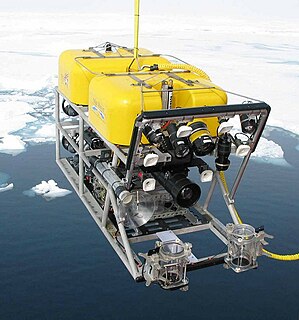 W
WA remotely operated underwater vehicle is a tethered underwater mobile device.
 W
WCURV-III was the fourth generation of the United States Navy Cable-controlled Undersea Recovery Vehicle (CURV). CURV was a prototype for remotely operated underwater vehicles and a pioneer for teleoperation. It became famous in 1966 when CURV-I was used to recover a hydrogen bomb from the floor of the Mediterranean Sea. In 1973, CURV-III performed the deepest underwater rescue in history when it rescued two men 1,575 feet (480 m) from the ocean surface who were stranded 76 hours in the submersible Pisces III with just minutes of air remaining. The CURV-III became known in the Great Lakes region in 1976 when it was used to survey the wreck of the SS Edmund Fitzgerald. CURV-21 is the current generation that replaced CURV-III.
 W
WÉpaulard is a French remotely operated underwater vehicle of the Ifremer. She is notable as the first robotic submarine capable of taking photographs at a depth of 6000 metres. Built in 1980, Épaulard was decommissioned in 1991.
 W
WGlobal Explorer ROV is a unique deep water remotely operated vehicle that has made numerous dives below 9,000 feet (2,700 m) on science and survey expeditions for National Geographic, the National Oceanographic and Atmospheric Administration (NOAA) and other research organizations. It was designed and built by Chris Nicholson of Deep Sea Systems International, Inc. of Falmouth, Massachusetts.
 W
WKaikō was a remotely operated underwater vehicle (ROV) built by the Japan Agency for Marine-Earth Science and Technology (JAMSTEC) for exploration of the deep sea. Kaikō was the second of only five vessels ever to reach the bottom of the Challenger Deep, as of 2019. Between 1995 and 2003, this 10.6 ton unmanned submersible conducted more than 250 dives, collecting 350 biological species, some of which could prove to be useful in medical and industrial applications. On 29 May 2003, Kaikō was lost at sea off the coast of Shikoku Island during Typhoon Chan-Hom, when a secondary cable connecting it to its launcher at the ocean surface broke.
 W
WThe Mini Rover ROV was the world's first small, low cost remotely operated underwater vehicle (ROV) when it was introduced in early 1983. After a demonstration to industry professionals, in the Spring of 1984, it made a significant entry to the remotely operated vehicle market. It is a self-propelled, tethered, free swimming vehicle that was designed and built by Chris Nicholson of Deep Sea Systems International, Inc. (DSSI). The Mini Rover ROV entered the ROV market at a price of $26,850 when the next lowest cost ROV was $100,000. Nicholson built the first Mini Rover ROV in his garage in Falmouth, MA. It was 26 inches long and weighed 55 pounds. It could be carried on airplanes as luggage.
 W
WOpenROV is a low-cost telerobotic submarine/underwater drone built with the goal of making underwater exploration and education affordable.
 W
WThe Scorpio is a brand of underwater submersible Remotely Operated Vehicle (ROV) manufactured by Perry Tritech used by sub-sea industries such as the oil industry for general operations, and by the Royal Navy and the United States Navy for submarine rescue services. Originally developed by AMETEK Straza of El Cajon, United States, they were subsequently developed by Perry Tritech. Although the design of the original Scorpio is over several decades old, it forms the basis for a current generation of Scorpio-branded ROVs. Scorpio ROVs are named in a sequence following the order of manufacture, such as "Scorpio 17" or "Scorpio 45" which refer to specific ROVs.
 W
WThe Seafox is an anti-mine remotely operated vehicle (ROV) manufactured by German company Atlas Elektronik to locate and destroy ground and moored mines. There are two versions and a training version. The orange Seafox-I "inspection" variant has sonar and an Inertial navigation system, and the black Seafox-C "combat" round has a 1.4 kg shaped charge warhead. The system is in service with eleven Navies across seventy platforms.
 W
WVideoRay ROVs are a series of inspection class underwater submersible remotely operated underwater vehicles (ROV). VideoRay ROVs are operated from a suitcase-sized control panel connected to either a copper or fiber-optic tether which is then connected to the submersible.